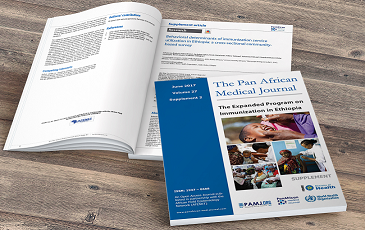Polymalformative syndrome in congenital cytomegalovirus infection: a case report
Houssem Ragmoun, Sarra Rihani, Aymen Khalfaoui, Montacer Hafsi, Amina Abaab, Mariem Bezzine, Kristou Eya, Aida Masmoudi
Corresponding author: Aymen Khalfaoui, Department of Gynecology and Obstetrics, Regional Hospital of Menzel Temim, 8080, Menzel Temim, Nabeul, Tunisia 
Received: 29 Mar 2025 - Accepted: 03 Jun 2025 - Published: 18 Jun 2025
Domain: Radiology,Neurology (general),Obstetrics and gynecology
Keywords: Congenital cytomegalovirus, polymalformative syndrome, prenatal ultrasound, fetal anomalies, case report
Funding: This work received no specific grant from any funding agency in the public, commercial, or not-for-profit sectors.
©Houssem Ragmoun et al. PAMJ Clinical Medicine (ISSN: 2707-2797). This is an Open Access article distributed under the terms of the Creative Commons Attribution International 4.0 License (https://creativecommons.org/licenses/by/4.0/), which permits unrestricted use, distribution, and reproduction in any medium, provided the original work is properly cited.
Cite this article: Houssem Ragmoun et al. Polymalformative syndrome in congenital cytomegalovirus infection: a case report. PAMJ Clinical Medicine. 2025;18:5. [doi: 10.11604/pamj-cm.2025.18.5.47428]
Available online at: https://www.clinical-medicine.panafrican-med-journal.com//content/article/18/5/full
Polymalformative syndrome in congenital cytomegalovirus infection: a case report
Houssem Ragmoun1, Sarra Rihani1, ![]() Aymen Khalfaoui1,&, Montacer Hafsi1, Amina Abaab1, Mariem Bezzine1, Kristou Eya1, Aida Masmoudi1
Aymen Khalfaoui1,&, Montacer Hafsi1, Amina Abaab1, Mariem Bezzine1, Kristou Eya1, Aida Masmoudi1
&Corresponding author
Congenital cytomegalovirus (CMV) infection is a common intrauterine infection and a major cause of neurodevelopmental impairment, yet its severe prenatal manifestations are often underrecognized. We report the case of a 28-year-old primigravida referred at 24 weeks of gestation for suspected fetal anomalies. Ultrasound revealed microcephaly, cerebellar hypoplasia, near agenesis of the corpus callosum, ventriculomegaly, hyperechogenic bowel, adrenal calcifications, and pericardial effusion. Congenital cytomegalovirus (CMV) deoxyribonucleic acid (DNA) was detected in the amniotic fluid by PCR, confirming congenital infection. Given the poor prognosis, medical termination of pregnancy was performed according to FIGO guidelines. Fetopathological examination confirmed severe encephaloclastic brain damage consistent with CMV embryopathy. This case highlights the critical role of prenatal imaging in the early detection of congenital CMV, the value of amniocentesis for definitive diagnosis, and the importance of early multidisciplinary counseling. Raising awareness of such severe presentations can improve antenatal diagnosis and help guide parental decision-making.
Congenital cytomegalovirus (CMV) infection is the most common congenital viral infection worldwide, affecting approximately 0.5% to 2% of all live births [1]. It is a major non-genetic cause of sensorineural hearing loss, visual impairment, epilepsy, and neurodevelopmental delay in children [2]. Congenital cytomegalovirus (CMV) is a ubiquitous herpesvirus that can be transmitted to the fetus transplacentally, especially during a primary maternal infection in early pregnancy, which carries the highest risk of severe fetal damage [3]. The clinical presentation of congenital CMV is highly heterogeneous. While many infected newborns are asymptomatic at birth, approximately 10-15% show signs of disease, which can range from isolated abnormalities to severe polymalformative syndromes involving the central nervous system, hepatosplenomegaly, growth restriction, and calcifications [2]. Neuroimaging may reveal ventriculomegaly, microcephaly, cerebral calcifications, and migrational abnormalities, reflecting the virus's predilection for the developing brain [4]. We report a case of congenital CMV infection diagnosed prenatally, presenting with a complex polymalformative syndrome and severe cerebral involvement.
Patient information: a 28-year-old woman, gravida 1 para 0, with blood type A-positive and no significant medical, surgical, or family history, was referred at 24 weeks and 3 days of gestation for evaluation of a suspected fetal polymalformative syndrome. The pregnancy was spontaneous and there was no consanguinity with the father. She had no known exposure to teratogens or infectious agents during the first trimester.
Timeline of the current episode: the patient underwent a first-trimester screening at 12 weeks and 2 days of gestation. The crown-rump length measured 54 mm and the nuchal translucency was 0.75 mm. First-tier maternal serum screening (MST1) indicated an intermediate risk for trisomy 21 (1/875), while the second-tier screening (MST2) later suggested a low risk for trisomies 21, 18, and 13. At 24 weeks and 3 days, a morphological ultrasound revealed multiple central nervous system and systemic anomalies. Serologic testing was requested to investigate potential intrauterine infections.
Clinical findings: the detailed fetal ultrasound revealed significant cerebral anomalies including mild ventriculomegaly (10-12 mm) (Figure 1) porencephaly (Figure 2), microcephaly (Figure 3), Blake´s pouch cyst, vermian and cerebellar hypoplasia (Figure 4), subependymal periventricular heterotopia, near-complete agenesis of the corpus callosum, and agenesis of the septum pellucidum. Cardiovascular anomalies included a slight cardiomegaly and pericardial effusion. Abdominal findings showed hyperechoic intestines and bilateral adrenal calcifications (Figure 5). There were no apparent external malformations.
Diagnostic assessment: maternal laboratory investigations showed a hemoglobin level of 12 g/dL, platelet count of 225,700/mm3, and fasting blood glucose of 0.91 g/L. Serological screening revealed immunity to rubella, non-immunity to toxoplasmosis, and negative results for syphilis, hepatitis B surface antigen, and Rh antibodies. CMV serology was suggestive of a primary maternal infection. Amniocentesis was performed, and polymerase chain reaction (PCR) detected CMV DNA in the amniotic fluid, confirming congenital CMV infection. Fetal MRI was not performed due to the extensive anomalies already demonstrated by ultrasound and confirmed by the presence of positive CMV DNA in the amniotic fluid.
Diagnosis: the final diagnosis was a severe polymalformative syndrome associated with congenital cytomegalovirus infection, with predominant and extensive central nervous system involvement.
Therapeutic interventions: in view of the poor fetal prognosis, a medical termination of pregnancy was proposed and accepted. Termination was performed in accordance with FIGO guidelines using vaginal administration of misoprostol (Cytotec). The procedure was completed without complications, and no surgical intervention was necessary.
Follow-up and outcome of interventions: the fetus was delivered stillborn with no external dysmorphic features. Fetopathological examination confirmed the prenatal findings. Abdominal findings included adrenal dystrophic calcifications, hyperechoic intestines, and a mottled, congested liver (Figure 6). Neuropathological findings included microcephaly, cerebellar hypoplasia, near-complete agenesis of the corpus callosum, porencephaly, and a teardrop configuration of the lateral ventricles with mild ventriculomegaly (Figure 7). These findings were consistent with the encephaloclastic effects of congenital CMV infection.
Patient perspective: the patient and her family were informed in detail about the severity of the fetal anomalies and the grave neurological prognosis. After thorough counseling, they consented to termination. The patient experienced emotional distress but expressed understanding and acceptance of the decision, emphasizing the importance of avoiding long-term suffering for the child.
Informed consent: written informed consent was obtained from the patient for the medical termination of pregnancy and for the publication of this case report. All identifying details have been anonymized to preserve confidentiality.
Polymalformative syndrome associated with congenital cytomegalovirus (CMV) infection is a complex condition characterized by multisystemic abnormalities, particularly affecting the central nervous system (CNS), auditory system, eyes, and heart. Congenital CMV infection can arise from primary maternal infection, reinfection, or viral reactivation, with primary infection during pregnancy posing the highest risk of severe fetal sequelae [4]. The clinical manifestations of congenital CMV infection are highly variable, ranging from asymptomatic cases to severe, life-threatening anomalies, depending on the timing of infection and the extent of fetal involvement [1].
Prenatal ultrasound plays a critical role in identifying features suggestive of congenital cytomegalovirus (CMV) infection, with findings categorized into several key domains [5]. Placental abnormalities, such as a thickened placenta, may be among the earliest indicators. Growth abnormalities, particularly intrauterine growth restriction (IUGR), reflect the systemic impact of the infection. Abdominal findings commonly include hyperechoic bowel, meconium peritonitis, hepatosplenomegaly due to cholestatic hepatitis, and hepatic calcifications [6]. Hydropic features, including ascites, pericardial effusion, and anasarca, may result from fetal anemia or cardiac dysfunction [1]. Renal involvement is suggested by hyperechogenic kidneys, while cardiac manifestations can include cardiomyopathy and structural heart defects [1]. The central nervous system is especially vulnerable, with characteristic findings such as destructive or obstructive ventriculomegaly, hyperechoic ventricular walls, intraventricular hemorrhage, microcephaly with punctate periventricular calcifications (often described as “candelabra” calcifications due to vasculitis), posterior fossa anomalies like cerebellar hypoplasia, parenchymal lesions, as well as corpus callosum abnormalities and cortical malformations such as schizencephaly [7].
In our case, the prenatal ultrasound revealed severe CNS anomalies, including microcephaly, cerebellar hypoplasia, nearly complete agenesis of the corpus callosum, porencephaly, and mild ventriculomegaly (Figure 1), findings that have been extensively reported in association with congenital CMV infection [1]. The presence of periventricular heterotopia and subependymal cysts in our case further highlights the neurotropic nature of CMV and its role in neuronal migration disorders. These findings are consistent with reports in the literature describing cortical malformations and periventricular calcifications as hallmark features of congenital CMV infection [1].
Additionally, our case demonstrated hyperechoic intestines, adrenal dystrophic calcifications, and mild cardiomegaly with pericardial effusion, which align with systemic manifestations commonly observed in congenital CMV embryopathy [7]. The presence of adrenal calcifications is less frequently reported in the literature but has been described in severe cases, possibly reflecting prior ischemic or hemorrhagic events related to the infection [1]. The definitive diagnosis of congenital CMV infection is achieved by detecting CMV DNA in the amniotic fluid via amniocentesis. This procedure should be performed at least seven weeks after maternal seroconversion to minimize the risk of false-negative results due to delayed viral shedding into the amniotic fluid [5]. However, false positives can occur due to maternal blood contamination, while false negatives may arise if the procedure is performed too early in the course of infection [1].
Brain anomalies detected on prenatal ultrasound are strongly associated with poor neurological outcomes. Specific findings, such as microcephaly, ventriculomegaly, and schizencephaly, are indicative of an unfavorable prognosis and often justify medical termination of pregnancy, particularly when the anomalies are severe and incompatible with a good quality of life [5]. The decision to terminate a pregnancy is typically based on the severity of the anomalies rather than the CMV etiology alone, as the extent of CNS damage is a critical determinant of long-term outcomes [1]. Even in cases where the fetus appears asymptomatic prenatally, congenital CMV infection can lead to significant postnatal complications. These include delayed neurosensory development, sensorineural hearing loss, chorioretinitis, and hepatosplenomegaly [6]. Sensorineural hearing loss, in particular, is a common sequela, affecting up to 10-15% of asymptomatic infants and up to 50% of symptomatic infants [7].
Early identification and intervention are crucial to mitigate the long-term impact of these complications. Emerging technologies promise to improve prenatal CMV screening. Notably, next-generation non-invasive prenatal testing (NIPT) platforms can incidentally detect CMV DNA fragments in maternal plasma [8]. A recent large study used genome-wide cfDNA sequencing (performed for routine aneuploidy screening) in over 200,000 pregnancies and found CMV cfDNA in ˜0.9% of samples. High CMV-cfDNA loads correlated with serologic evidence of recent primary infection, and even low-level cfDNA in the first trimester was later associated with severe fetal infection [1]. These findings suggest that a single first-trimester blood draw could simultaneously screen for chromosomal abnormalities and flag active CMV infection [8].
Early prenatal detection of CMV is clinically important. Identifying an infected pregnancy allows timely counseling about prognosis (risk of neurodevelopmental impairment, hearing loss, and multisystem malformations) and informs management decisions [9]. For example, several trials now show that antiviral therapy (such as high-dose valacyclovir) or hyperimmune globulin given shortly after maternal seroconversion can significantly reduce maternal-fetal transmission [9]. Our case highlights the importance of prenatal ultrasound in detecting severe CMV-related anomalies and emphasizes the role of early serological screening and confirmatory amniocentesis in guiding clinical decision-making. The findings further reinforce that, despite advancements in diagnostic techniques, congenital CMV remains a major cause of fetal morbidity, necessitating further research into potential therapeutic interventions to improve outcomes for affected pregnancies.
In this case of congenital CMV infection, the prenatal ultrasound findings of severe brain anomalies led to the early diagnosis and decision for medical termination due to the poor neurological prognosis. This case underscores the critical role of prenatal ultrasound and timely amniocentesis in diagnosing congenital CMV infection and guiding clinical decisions. The take-home message is that close monitoring of pregnancies at risk for congenital CMV, along with early detection of severe neurological involvement, is essential for optimizing maternal and fetal outcomes.
The authors declare no competing interests.
Patient management: Houssem Ragmoun and Aymen Khalfaoui. Data collection: Houssem Ragmoun, Mariem Bezzine, and Amina Abaab. Manuscript drafting: Aymen Khalfaoui. Manuscript revision: Houssem Ragmoun, Mariem Bezzine, and Amina Abaab. All the authors have read and agreed to the final manuscript.
Figure 1: tear drop sign (star) and ventriculomegaly (arrow) in fetal ultrasound
Figure 2: porencephaly on fetal ultrasound (arrow)
Figure 3: micorcephaly on fetal ultrasound (arrow)
Figure 4: cerebellar hypoplasia (arrow) on fetal ultrasound
Figure 5: adrenal calcifications (arrow) and hyperechoic intestines (flash) in fetal ultrasound
Figure 6: fetal autopsy showing visceral organ findings: intestines appeared hyperechoic, consistent with meconium peritonitis (arrow), and the liver showed congestion and mottling (star)
Figure 7: porencephaly (arrow) in fetal autopsy
- Kenneson A, Cannon MJ. Review and meta-analysis of the epidemiology of congenital cytomegalovirus (CMV) infection. Reviews in Medical Virology. 2007;17(4):253-276. PubMed | Google Scholar
- Goderis J, De Leenheer E, Smets K, Van Hoecke H, Keymeulen A, Dhooge I. Hearing loss and congenital CMV infection: a systematic review. Pediatrics. 2014 Nov;134(5):972-82. PubMed | Google Scholar
- Tominaga I, Kaïhou M, Kimura T, Onaya M, Kashima H, Kato Y et al. Cytomegalovirus fetal infection. Porencephaly with polymicrogyria in a 15-year-old boy. Rev Neurol (Paris). 1996 Jun-Jul;152(6-7):479-82. PubMed | Google Scholar
- Rawlinson WD, Boppana SB, Fowler KB, Kimberlin DW, Lazzarotto T, Alain S et al. Congenital cytomegalovirus infection in pregnancy and the neonate: consensus recommendations for prevention, diagnosis, and therapy. Lancet Infect Dis. 2017 Jun;17(6):e177-e188. PubMed | Google Scholar
- Enders G, Bäder U, Lindemann L, Schalasta G, Daiminger A. Prenatal diagnosis of congenital cytomegalovirus infection in 189 pregnancies with known outcome. Prenat Diagn. 2001 May;21(5):362-77. PubMed | Google Scholar
- Picone O, Simon I, Benachi A, Brunelle F, Sonigo P. Comparison between ultrasound and magnetic resonance imaging in assessment of fetal cytomegalovirus infection. Prenat Diagn. 2008 Aug;28(8):753-8. PubMed | Google Scholar
- Guerra B, Lazzarotto T, Quarta S, Lanari M, Bovicelli L, Nicolosi A et al. Prenatal diagnosis of symptomatic congenital cytomegalovirus infection. American journal of obstetrics and gynecology. 2000 Aug 1;183(2):476-82. Google Scholar
- Faas BH, Astuti G, Melchers WJ, Reuss A, Gilissen C, Macville MV et al. Early detection of active Human CytomegaloVirus (hCMV) infection in pregnant women using data generated for noninvasive fetal aneuploidy testing. EBioMedicine. 2024 Feb:100:104983. PubMed | Google Scholar
- Faas BHW, Meuleman T, Astuti G, Reuss A, Stol K, Sistermans EA et al. Detection of human cytomegalovirus cell-free DNA in pregnant women with symptomatically infected fetuses: proof-of-concept study. Ultrasound Obstet Gynecol 2025;65:470-7. PubMed | Google Scholar












